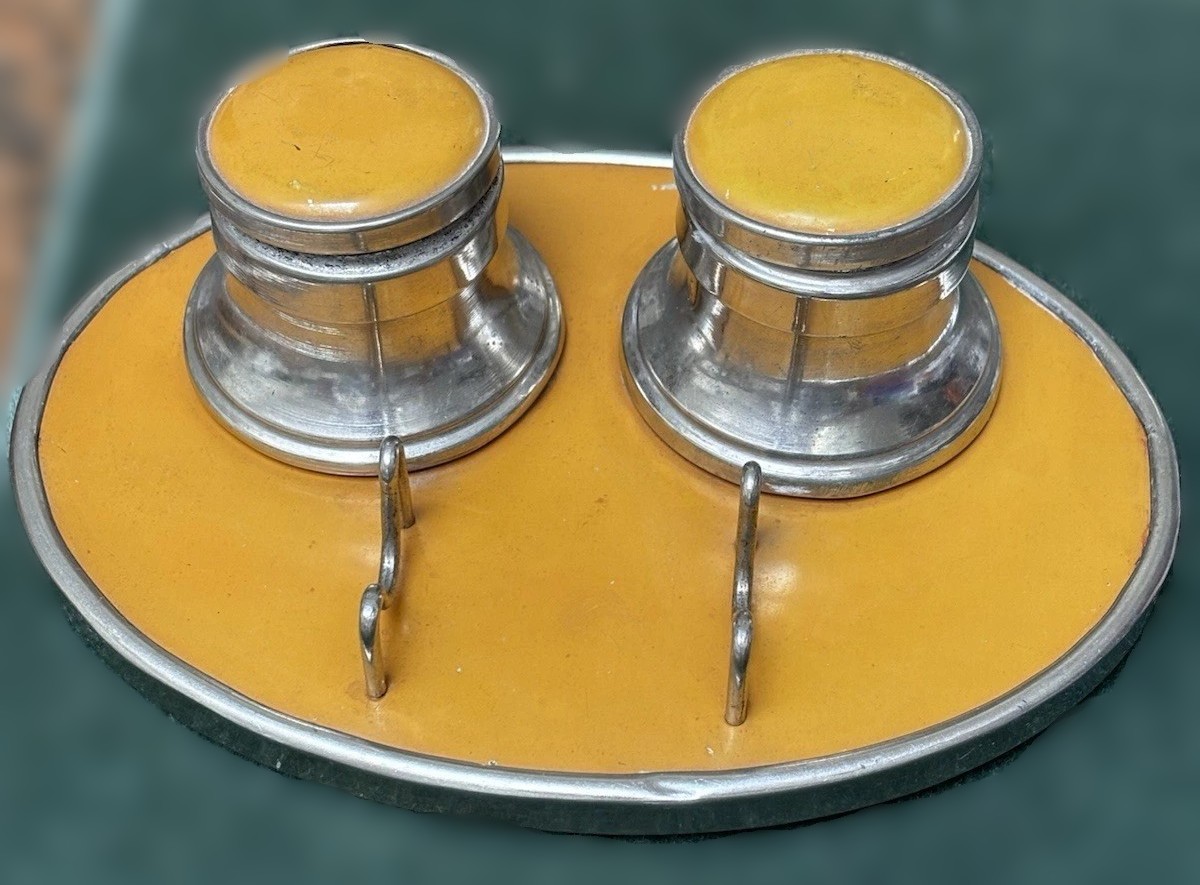
Art Deco Celluloid and Chrome Inkstand
| Categories | Art Deco |
| Material | Plastic/Celluloid |
| Markings | See Narrative |
| Manufacturer | Undetermined |
| Origin | Germany |
| Date or Era | circa 1930 |
| Measuring | 7” across |
This inkstand is a double-well desk set, distinguished by its use of contrasting modern materials: celluloid and chrome-plated metal.
- Materials and Construction: The piece sits on an oval base of smooth, polished, chrome-plated metal. The main body and the lids for the inkwells are constructed of celluloid, a shiny, early form of plastic.
- Color (Yellow): The celluloid is a vibrant, saturated yellow. A good descriptive color would be a “Egg Yolk” or “Mustard Yellow”—a deep yellow that contrasts sharply with the reflective chrome.
- Design and Components:
- Double Inkwells: Two cylindrical inkwell openings are set into the celluloid body.
- Lids: Each well has a matching, hinged, flat celluloid lid with chrome rims.
- Pen/Quill Rest: A chrome pen holder is built into the front.
- Overall Form: The design is has clean lines and has a streamlined, industrial, and geometric appearance.
Historical Context and Style – this inkwell exhibits characteristics of the Art Deco style.
- Geometric Form: The simple, clean shape is a hallmark of Art Deco, which celebrated symmetry and modern geometry, rejecting the elaborate curves of Art Nouveau.
- Materials: The combination of an early plastic like celluloid with sleek, polished metal (chrome) is characteristic of the Deco period (roughly 1920s to 1930s). Art Deco designers embraced new, machine-age materials.
- Color: The use of bright, contrasting, and solid colors (like this vibrant yellow) against a stark metallic base is typical of the bolder color palettes seen in Deco design.
“Made in Germany” and D.R.G.M.
The marking “Made in Germany” and a “D.R.P.M.” mark is a German patent designation.
- D.R.P.M. (Deutsches Reichs Gebrauchs-Muster) indicates the design was patented or registered in Germany during the period of the German Empire or the Weimar Republic. This mark was commonly used from the late 19th century up to 1945.
- Dating: The materials (celluloid and chrome) and the Deco design, combined with the German patent mark, suggest a manufacturing date roughly between the 1920s and the 1930s, placing it firmly in the Art Deco movement.
Sold for $90 in September 2025
Content disclaimer. The information posted is the owner’s best knowledge and may not have been vetted by the SOIC. We welcome comments, corrections, and additions, working to make our website information comprehensive and accurate.
Join the Society of Inkwell Collectors (SOIC) – it’s free!
Founded in 1981 as a non-profit organization,
we are documenting inkwells (and accessories).
We’re here to help and inform!











